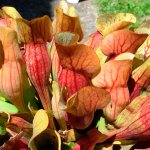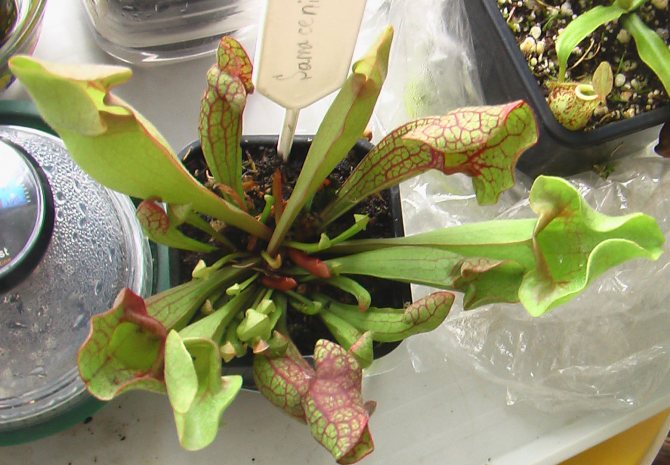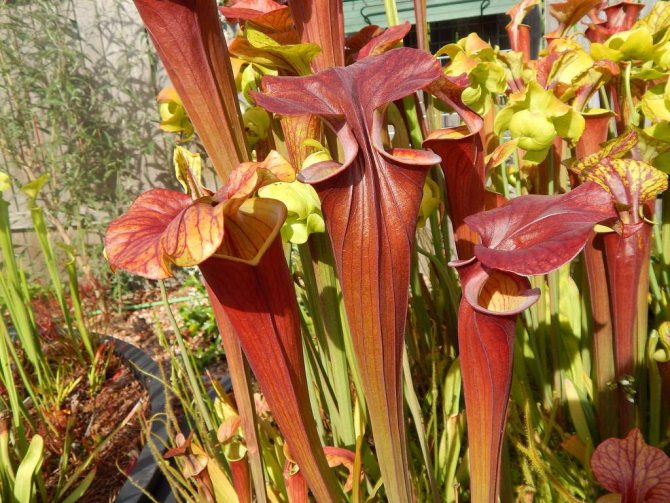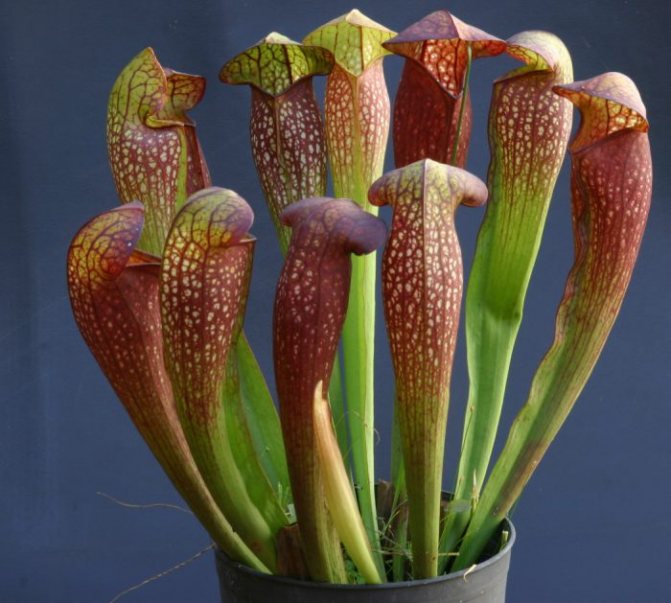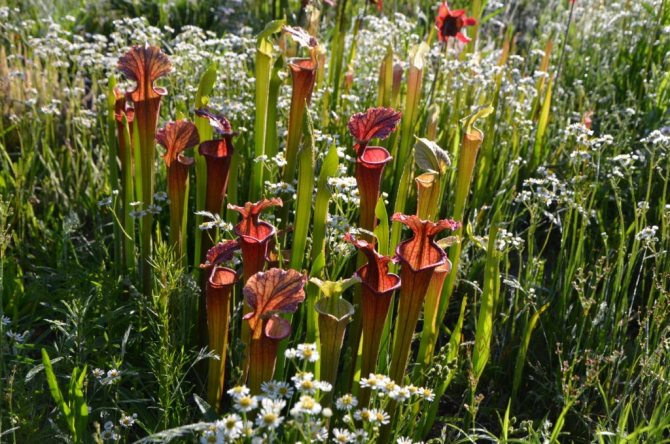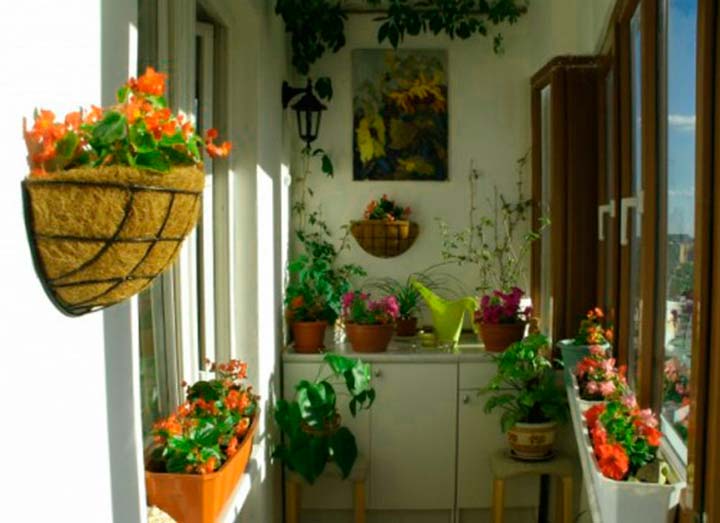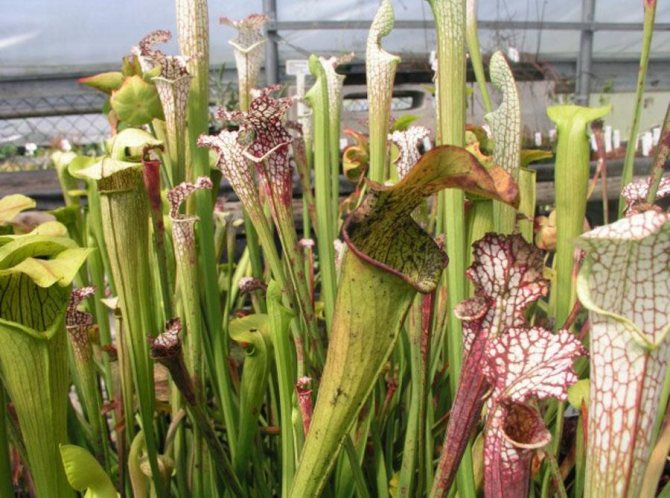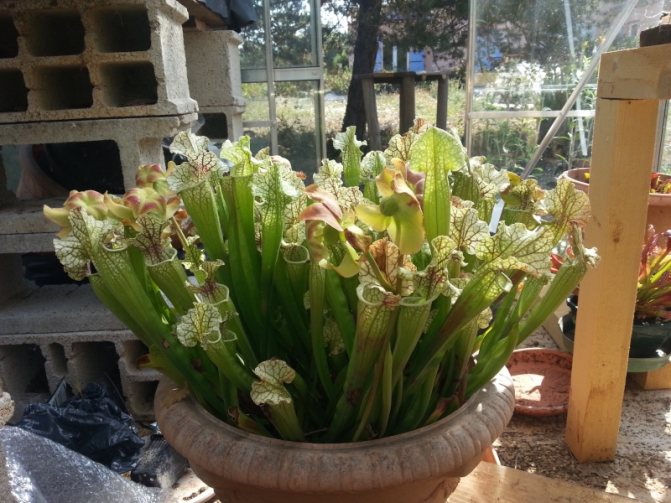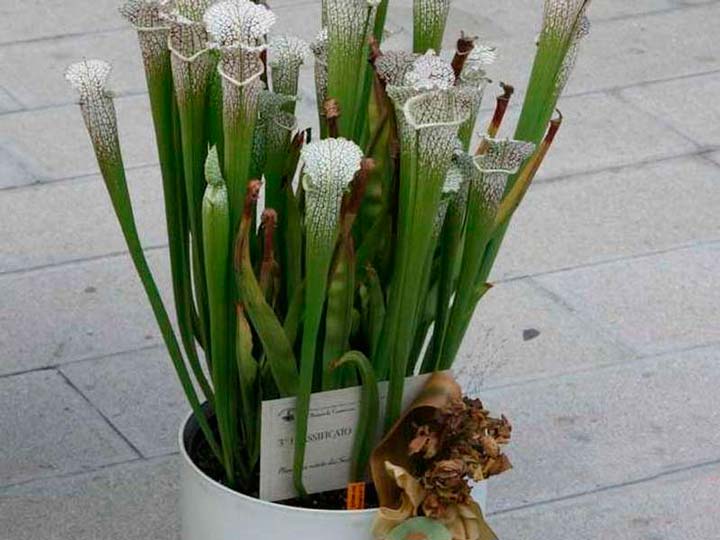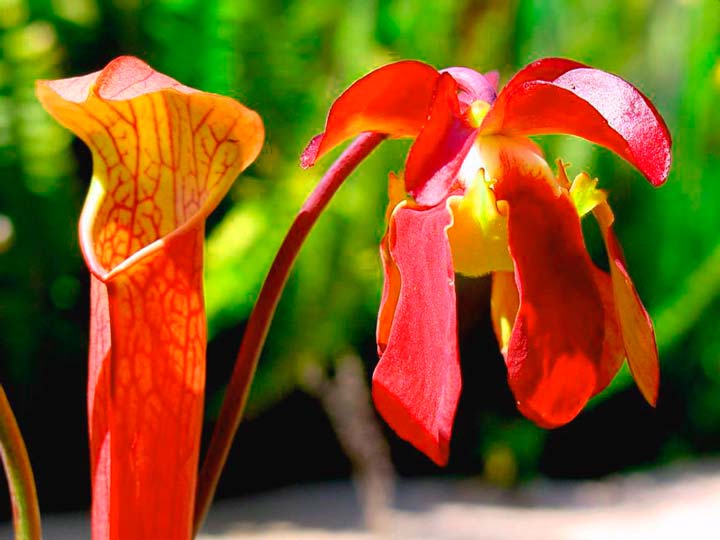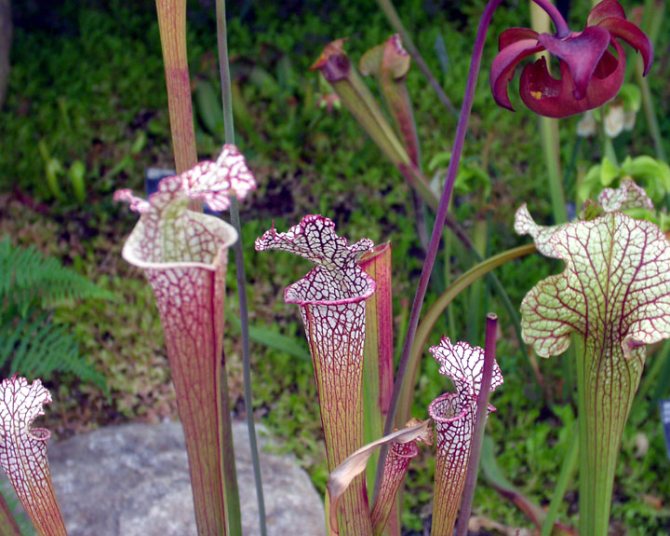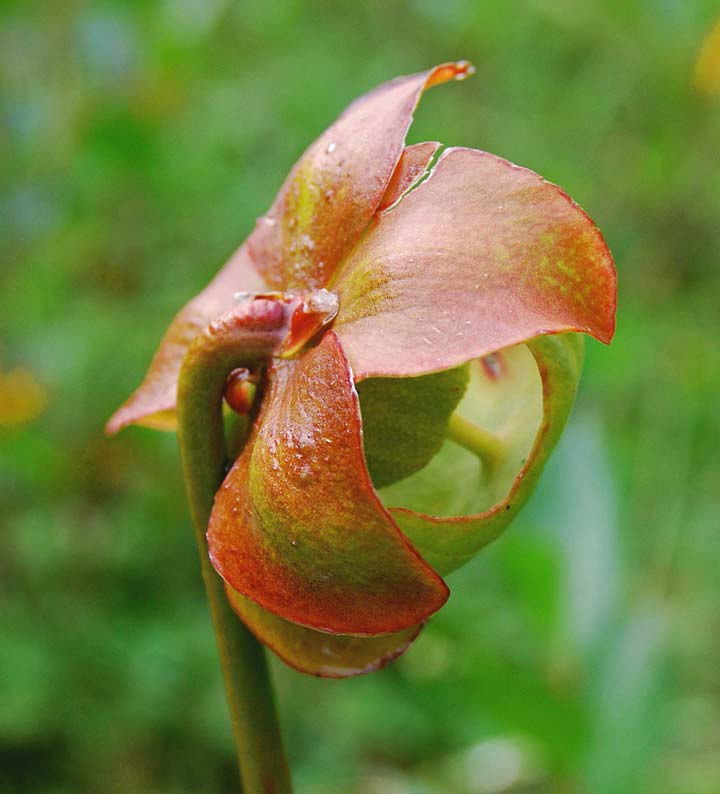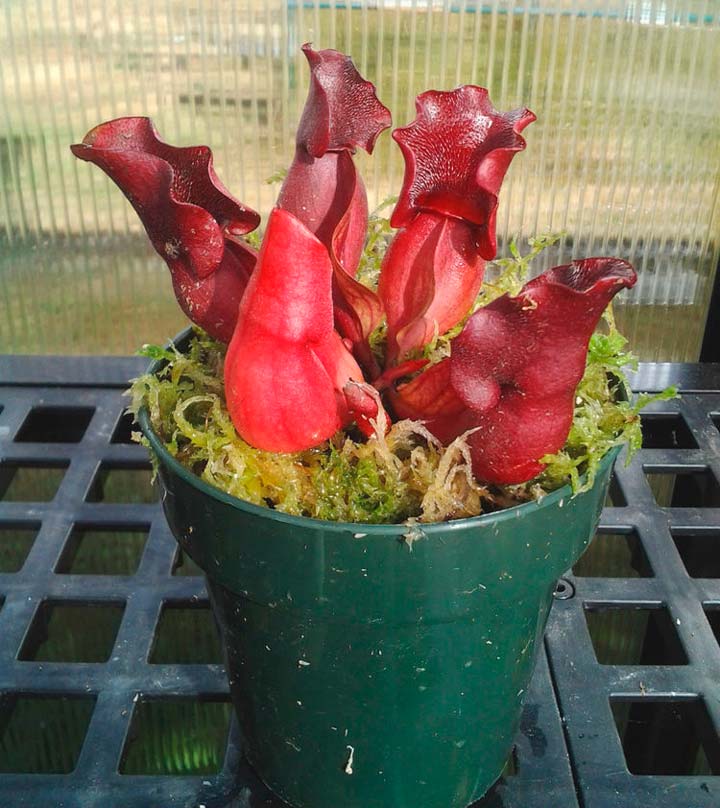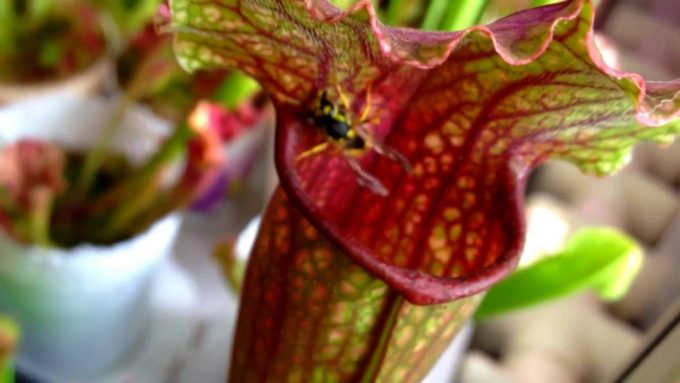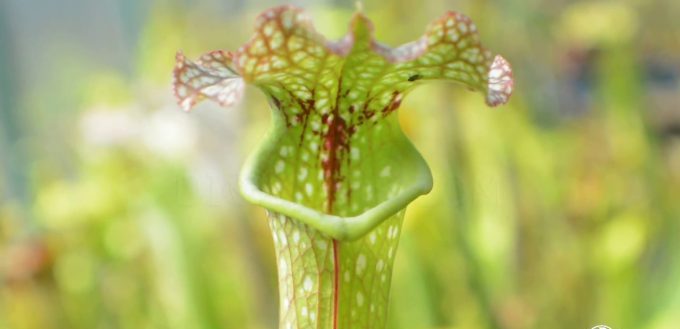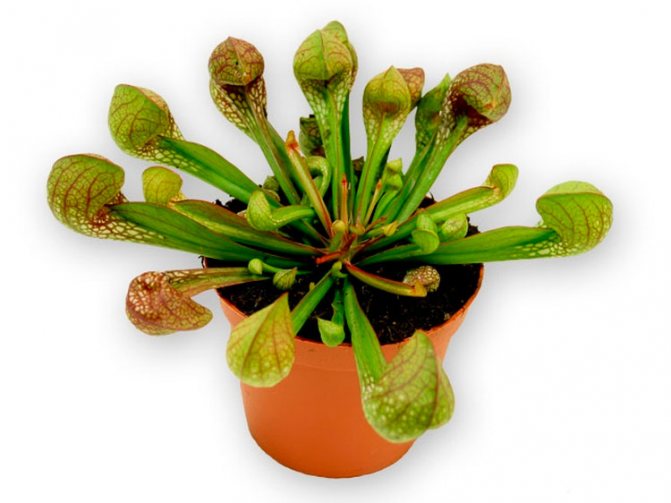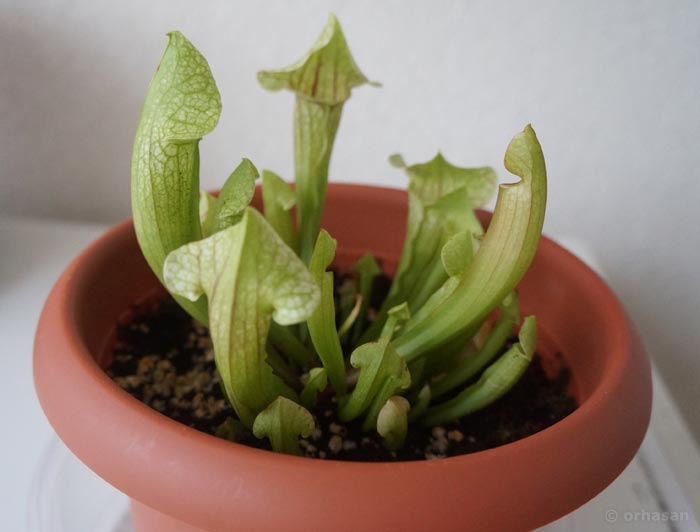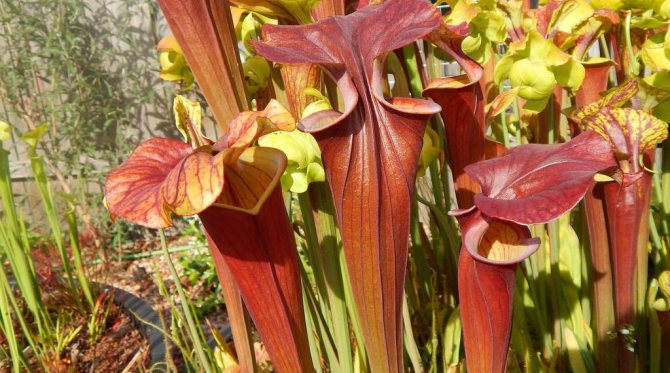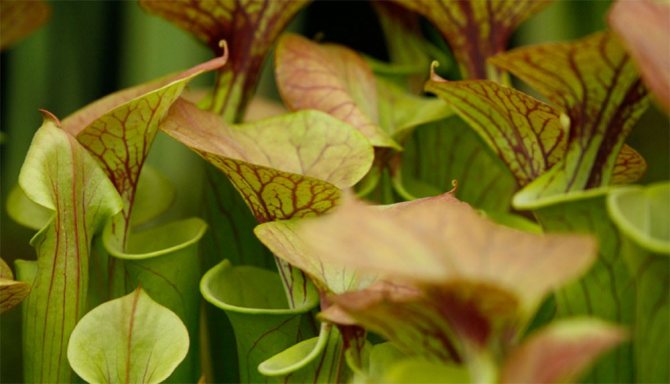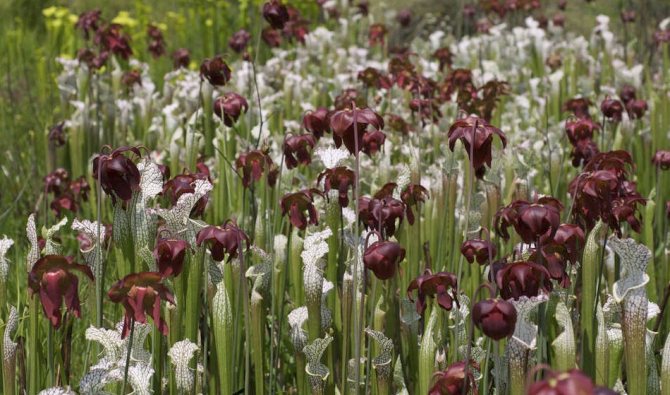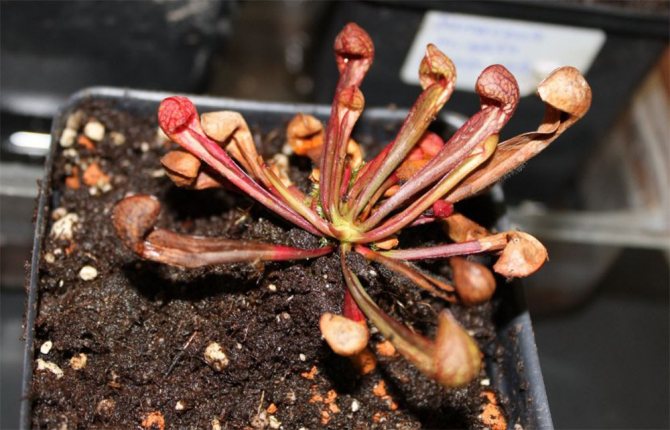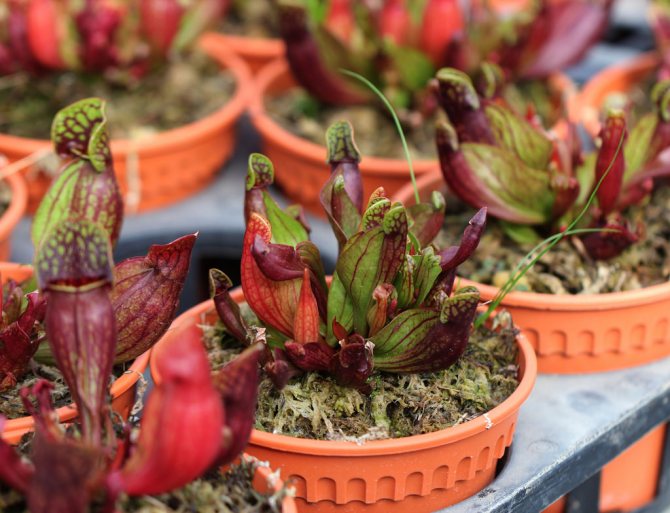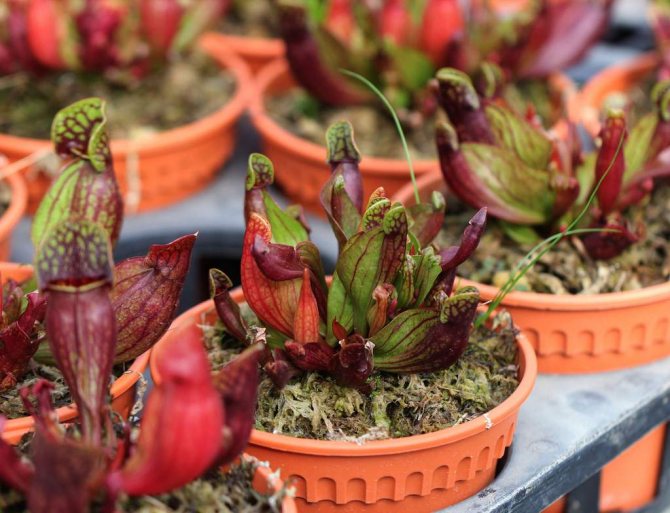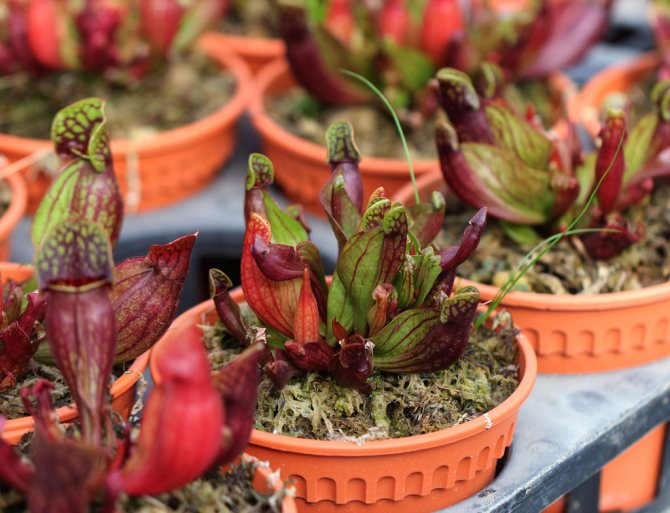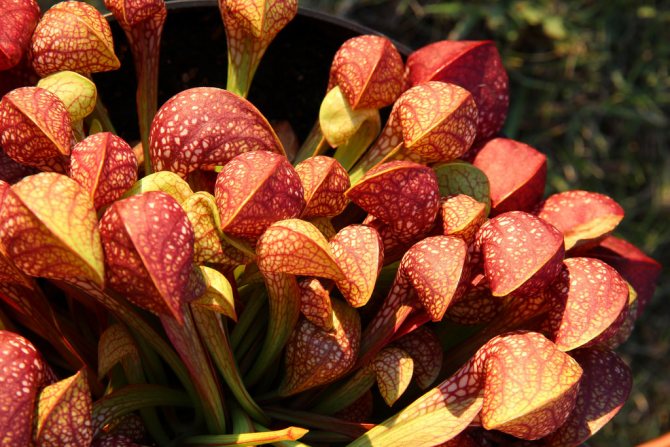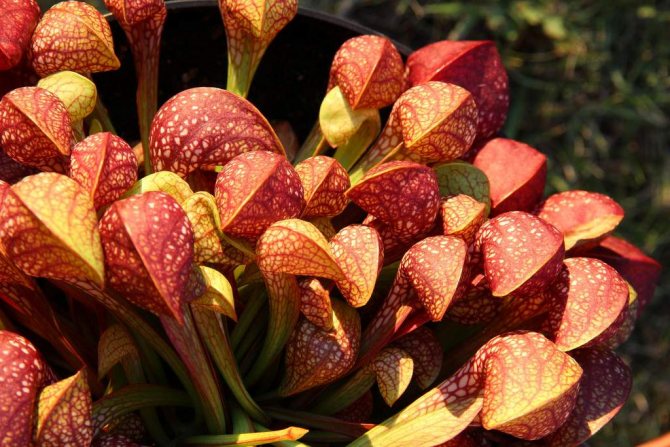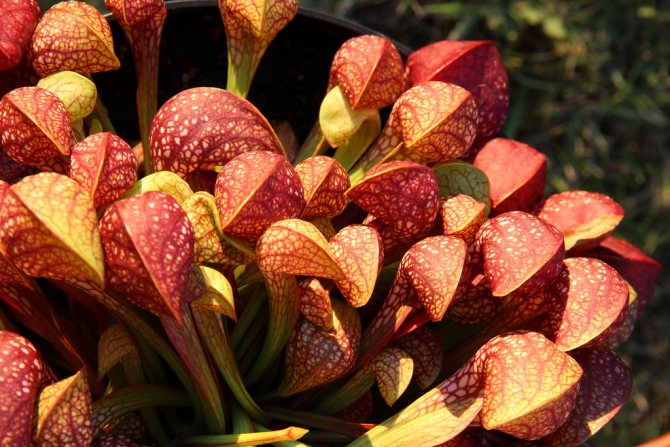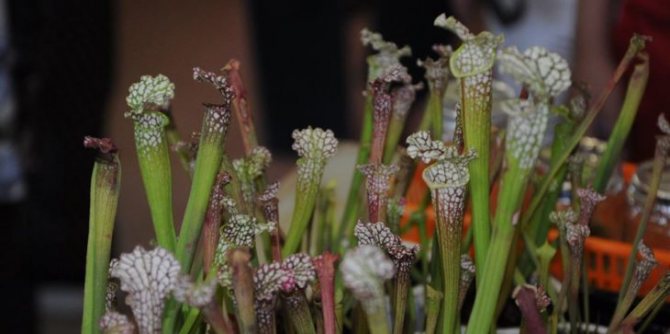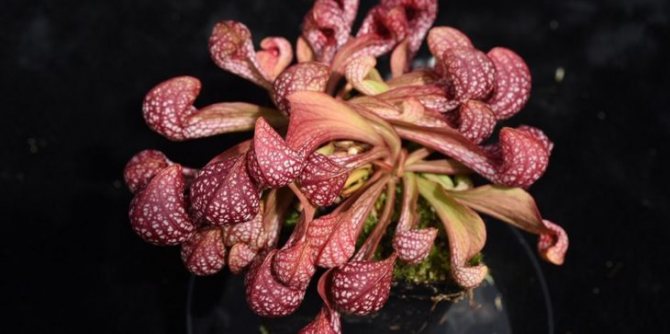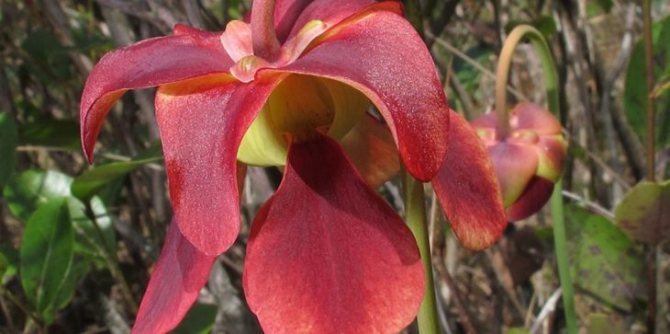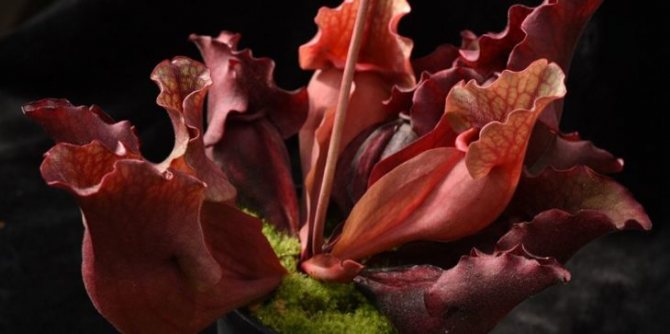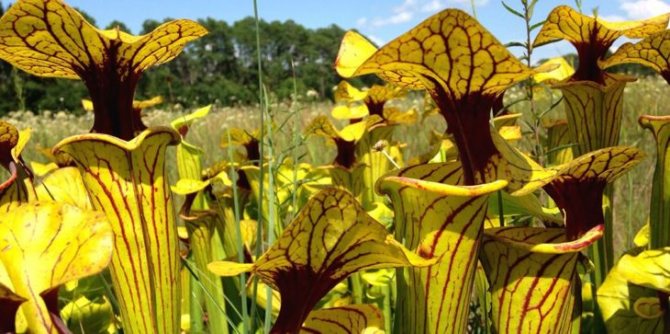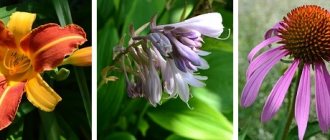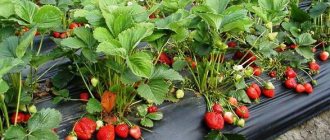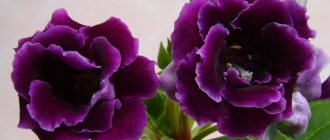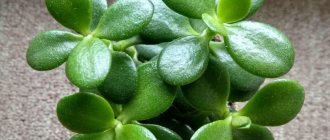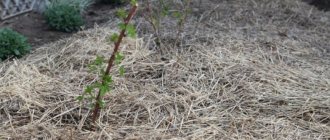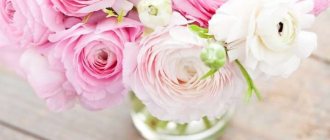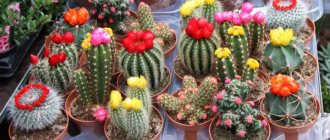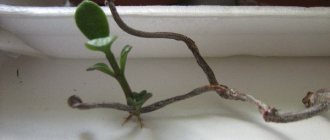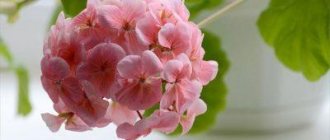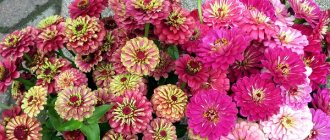Sarracenia - this bog, rhizome, herbaceous plant is a perennial. It is one of the largest carnivorous plants. Its leaves, located below, are scaly. Short-peaked trapping leaves, which are rather large, are collected in a rosette. They rise above the plant itself and the structure somewhat resemble an urn with a rather wide opening on top or a tubular jug.
This plant can only live in certain places, as it is endemic. So, it grows well and develops in the Atlantic-North American floristic zone. However, the purple sarracenia (Sarracenia purpurea), introduced to the swampy areas of Central Ireland, has perfectly settled there.
Sarracenia purpurea
The flowers are quite large and rich in color, they have a double perianth. They rise above the plant on a sturdy peduncle without leaves, which number from 1 to 3 per individual. This plant is distinguished by a very large, bizarrely shaped column in the form of an umbrella. It has not very large stigmas under the apex of each blade. In sarracenia purple, it is the largest in size.
There are such species, including the yellow sarracenia (Sarracenia flava), which form huge thickets in swampy areas. The tubular, ribbed pitchers of this plant extend almost vertically from the strong horizontal rhizome. In length, they can be about 70 or 80 centimeters.
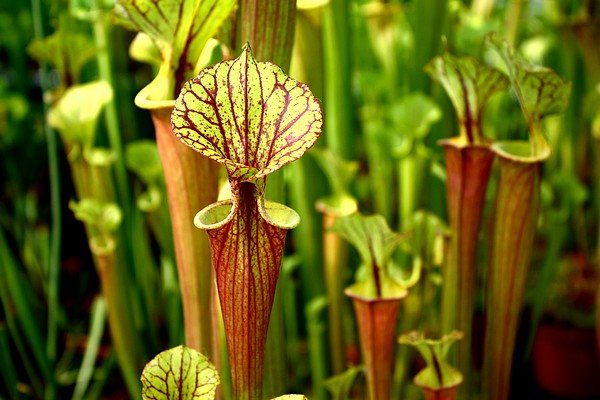
Sarracenia yellow (Sarracenia flava)
In other species, pitchers-traps are smaller and in length they reach from 10 to 40 centimeters. Most of them have a variegated color, in which yellow, purple and green predominate. The pattern located near the entrance to the trap is painted in the most intense colors, which makes it very visible to insects (even from a distance). Each trapping leaf has a pterygoid fringe on the side of the shoot. And its upper part is very similar to the lid. It plays the role of a kind of "umbrella", which is created from the upper blade of the leaf. He slightly closes the entrance to the trap, protecting it from the ingress of raindrops.
The insect prey is attracted by the very strong aroma of nectar. And its creator is the nectar-bearing gland, which is capable of forming relatively large quantities of nectar. An insect caught on a trapping leaf slides down the honey path. Inside, on the surface of the walls of such traps, there are special hairs that allow the victim to move exclusively downward. Then the victim finds himself in a storage trap and from there, he cannot get out in any way. After that, it gradually dissolves in the digestive juice. As a result, the plant receives nitrogen, magnesium, calcium, and potassium necessary for its life.
Interestingly, various birds consider the sarracenia to be a kind of feeder. They often peck insects that are not yet completely digested. There is information from scientists who say that in several cases, the remains of small tree frogs were found in such trap jugs.
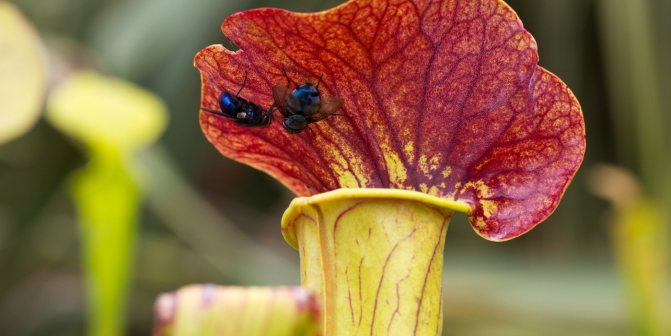

There are insects that can live comfortably inside these pitchers-traps.The fact is that they are capable of producing special substances that protect the insect from the effects of digestive juice. D. Fish (1976) studied this in more detail, and he writes that the larvae of the meat fly, the night moth with its larvae and the sphex wasp, which manages to make its nests in the same place, can live in trap jugs. These insects destroy most of the victims trapped in the trap. They also significantly damage leaf tissue, from which the traps can no longer function normally. As a result, these insects are capable of very much harm to entire populations of sarracenia.
There are very decorative types of sarracenia, and in some countries they have been grown for a very long time. The most popular is the yellow sarracenia. It is an ornamental perennial plant that has large, light orange flowers and juicy, beautifully curved light green pitchers. If at home they are provided with proper care and watered abundantly, then these plants will feel great even without additional feeding with insects. Also, purple sarracenia is very popular. Its fragrant flowers smell pleasantly of violets.
In just a few species of such a plant, the alkaloid saracenine was found in the leaves, as well as other aerial parts. It is used in medicine.
Choosing a place for sarcenia
Sarracenia is an exotic plant, and not every place in the apartment will suit her. The plant requires certain conditions for successful growth and development.
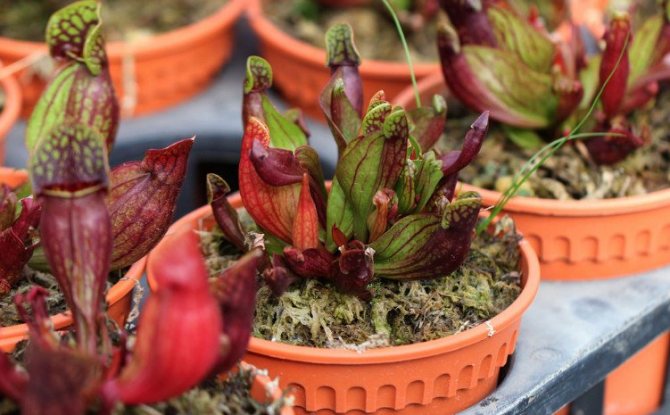

Temperature and humidity
For hardy carnivorous sarracenia, temperatures from zero to 35 ° C are suitable. For example, a constant temperature of 10 ° C is suitable for a safe wintering. Similarly, the increased humidity of sarracenia is not required - it is enough to provide it with a level of 35–40%. It is much more important for a plant that the substrate in the container where it grows is moistened.
Did you know? On sarracenia growing in natural conditions, birds and even frogs can parasitize, taking insects out of its "traps" as if in a trap. On the other hand, an excess of prey can ruin a flower, and such "freeloaders", it happens, appear very opportunely.
Lighting
The sun loves sarracenia; it is able to withstand direct sunlight, and even the hottest ones - midday, because in its natural environment it lives just in the sun. Despite its carnivorous predilections, sarracenia remains a plant with all their inherent characteristics - so, thanks to the parts painted in green, it carries out photosynthesis. For favorable growth, the flower will need the clearest place in the apartment - on the south or west side.
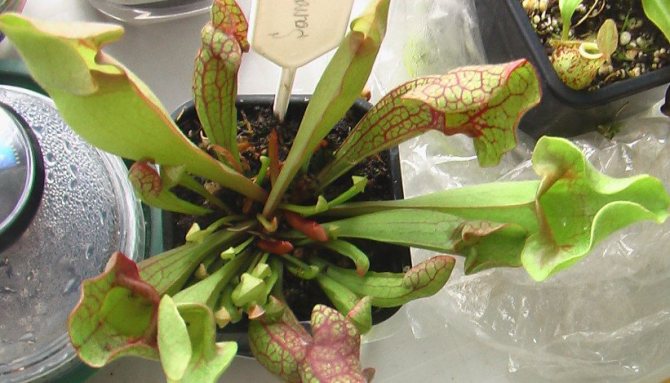

The plant needs to provide 8-10 hours of daylight hours. If there is not enough natural light, artificial light should be used. In the summertime, it is very good to take out the sarcenia on the balcony, veranda, in the garden. However, you should not abuse hyphenation: it is very bad about turning or changing places.
Did you know? In Canada, this predatory flower has many names: it is called "soldier's mug" and "devil's boot", "ancestor's cup" and "jug".
Video review
Botanical name: Sarracenia.
Homemade Sarracenia - family ... Sarracene.
Where grows ... US East Coast and Canada Southeast.
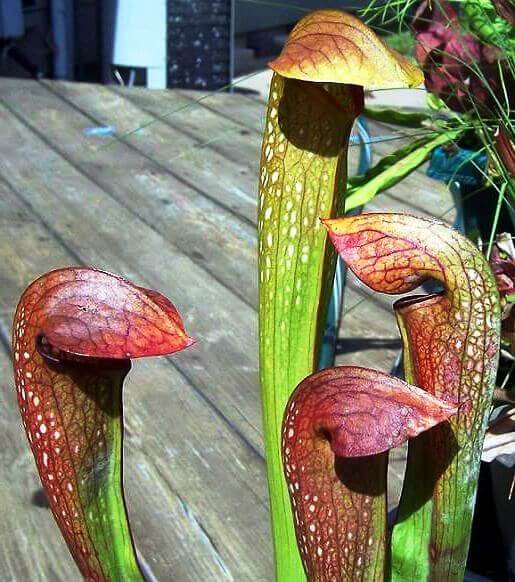

Description ... The genus Sarracenia contains only 8 species of carnivorous perennial plants, among which there are both evergreen and deciduous. Sarracenia leaves are collected in root rosettes, modified - they are deep, bright jugs. The shades of the pitchers are varied and include green, yellow, white, red and burgundy tones, often with contrasting veins. At the bottom of the jugs there is juice, which attracts insects.After the victim has got into the jug, it slides down the walls and the plant begins to digest food. Sarracenia blooms with small yellow, burgundy or greenish flowers in the spring months. Only adult plants, which are already several years old, bloom.
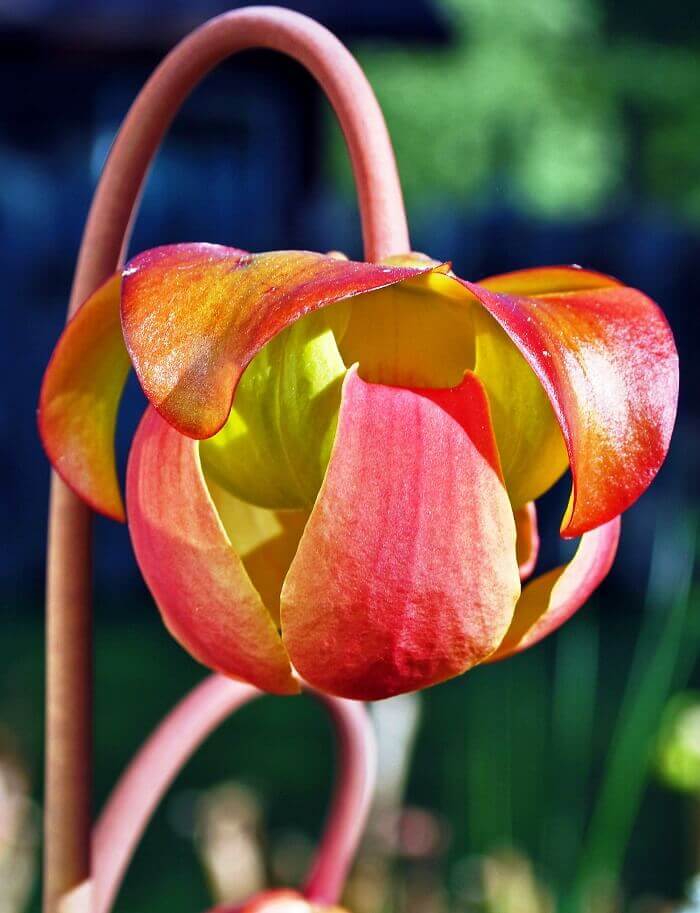

Height ... Sarracenia flower reaches a height of 20 to 80 cm, depending on the species.
Soil for sarracenia
Natural conditions for sarcenia are swamp, lake or river banks. On her own plot, she will like the pool or pond. For planting a plant at home, you can use a ready-made substrate intended for predatory plants, the acidity level of which is 4.5-6 pH.
You can prepare the soil for the predator yourself:
- equal parts of peat (you can take two parts) and perlite, which is soaked in distilled water for two weeks, changing it twice;
- 4 parts peat, 2 parts perlite and 1 part sand;
- 4 parts peat, 2 parts sphagnum moss, 2 parts sand, some charcoal.
Did you know? In reality, the traps of sarracenia - as, indeed, of other carnivorous plants - are not their flowers at all, but modified leaves.
Possible pests and methods of dealing with them
Aphids are quite a private guest on Sarracenia
The main pests that infest sarracenia include aphids and spider mites. They are carried through the air and fall from the street.
The symptoms of aphids are stickiness and deformation of the leaves, as well as the rapid wilting of flowers.
You can get rid of aphids, removing the damaged parts and treating the plant with nettle decoction or special preparations.
When a spider mite is affected, a thin light cobweb appears on the plant, the leaves become stained and fall off. The presence of a tick indicates insufficient air humidification.
To destroy the pest, you need to increase the humidity and spray the plant with an insecticide.
Planting, reproduction and transplantation of sarracenia
If the sarracenia grows in favorable conditions, its root system develops quickly enough, and the flower needs regular transplantation - annually or every two years.
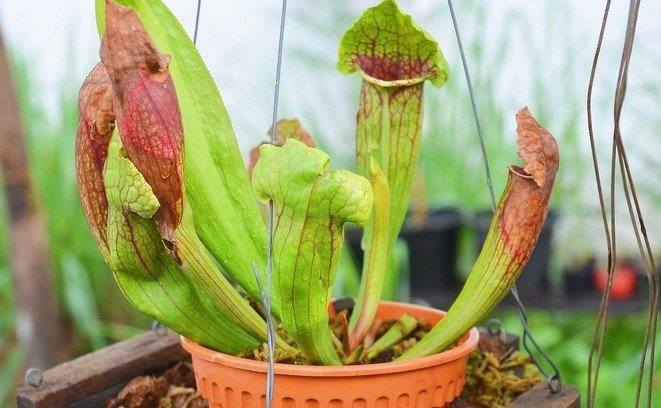

It is better to replant after a rest period in early spring.
- Two days before the procedure, it will be useful to treat the plant with "Epin" in the proportion of 4-5 drops per glass of water.
- In the process of transplanting, dry and spoiled leaves are removed and the roots are soaked, removing excess soil from them.
- Putting a drainage layer on the bottom of a previously prepared container, pour a substrate into it, moisten it and plant the plant in a hole made, deepening it by 3-4 cm.
- The planted flower is watered and placed in the place where it will be constantly.
- The transplanted plant is watered daily until complete engraftment.
The first landing takes place in the same way. Sarracenia propagates both vegetatively and by seed; the first method is convenient to use during transplantation.
Vegetative way
Vegetative propagation is practiced after the plant reaches a certain size so that the bush can be divided without harm to it. If you propagate a bush that is too young or fragile, the sarracenia becomes smaller and may even die. In the process of transplanting, the bush is divided into two divisions, and each of them is planted in a separate container.
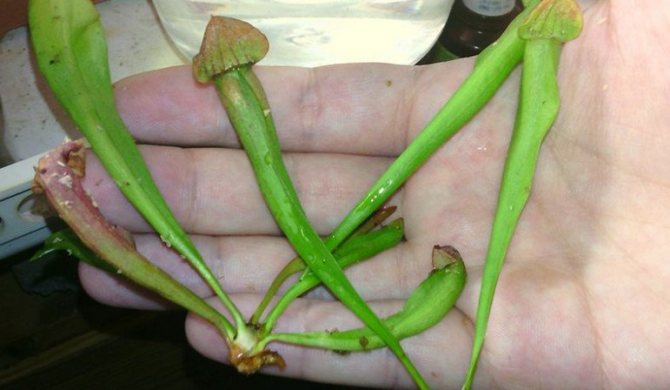

Important! It is not recommended to divide the sarracenia more than in two at a time, so as not to weaken and destroy it.
Seed method
You can propagate this amazing plant using seeds, sowing them in a Petri dish or similar container, and subsequently diving into a pot.
- Without fail, seeds must be stratified within one to two months. Without this procedure, they most likely will not ascend.
- The day before planting, they are soaked in warm water.
- The seeds are placed in a container with a mixture of quartz sand and sphagnum moss, moistening it with a spray bottle. You can sprinkle them on top a little.
- Crops must be covered with foil or glass and placed in a place where the temperature is maintained at 23-28 ° C.
- The greenhouse needs to be ventilated every two to three days, maintaining a constant moisture content of the substrate.
- When shoots appear, the glass or film is removed.
- A young sarracenia needs 16 hours of daylight. If it cannot be provided naturally, a phytolamp is required.
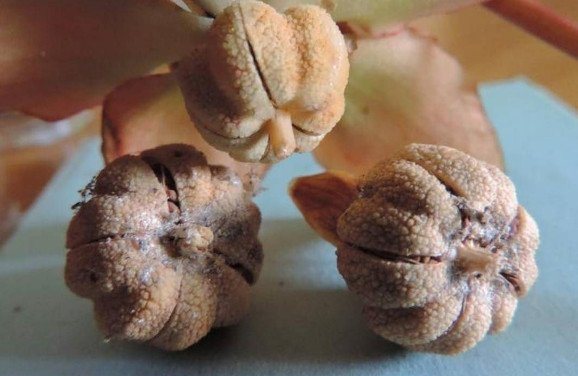

The sprouts will be ready at the time of transplanting in about a year, as they grow rather slowly. Young shoots are transplanted into a substrate for an adult carnivorous plant, using small pots 7-9 cm in diameter.
Did you know? Sarracenia and other predators prefer vegetative reproduction, since insects capable of pollinating them are eaten with appetite. The only bird that is able to cope with this task is the hummingbird, so they are in no hurry to part with the seed method.
Description of Saracenia
Saracenia (from Lat. Sarracenia) - refers to the predatory plant genus Sarracenia (perennial rhizome herbs).
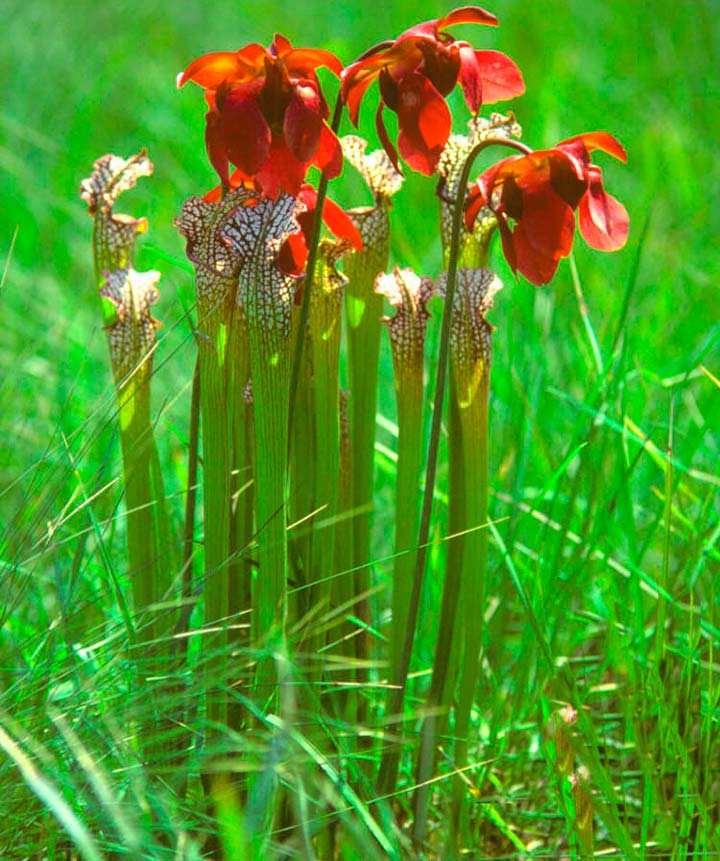

It is named after biologist Michel Sarrazen. The plant looks very extravagant, it doesn't look like anything.
Sarracenia flower, large, bright, unusual, rises above the leaves.
The trap itself is a twisted trap leaf, somewhat reminiscent of a water lily leaf.
It contains special glands that secrete fragrant nectar, which serves as bait for insects.
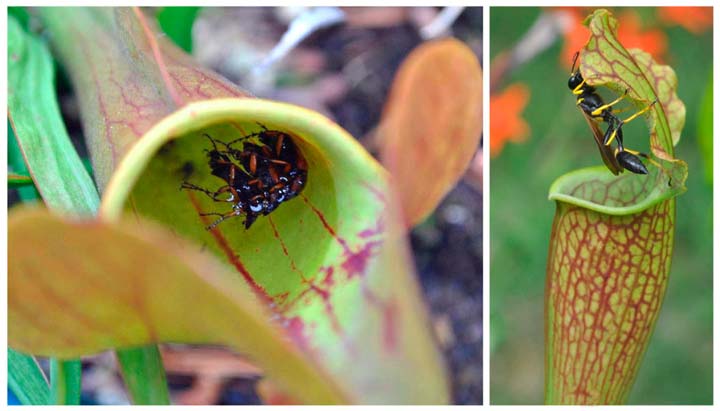

The victim sits on a trapping leaf, after which it rolls down the honey path below until it falls into a trap from which it is already impossible to get out. This is followed by the process of "digestion". It is known that in the lower part of the sarracenia, antimicrobial substances are released, due to which the victims who get there do not exude an unpleasant odor.
The carnivorousness of the plant is due to a lack of nutrients in the soil.
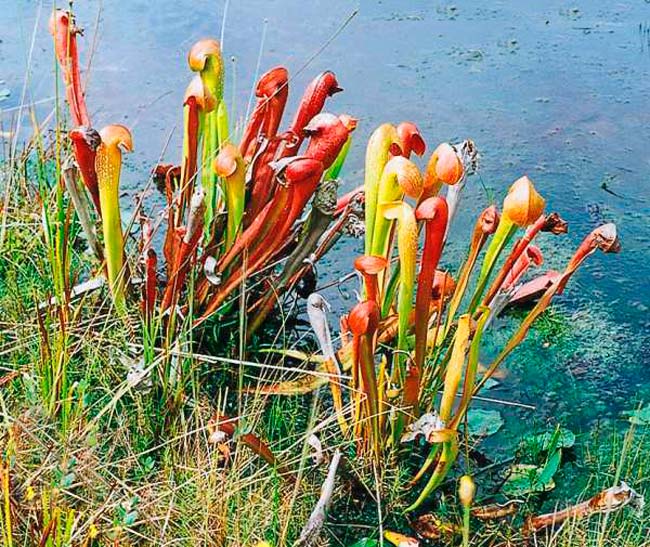

A carnivorous plant native to North and South America. In places where sarracenia grows, it is usually very humid - these are marshy soils, reservoirs. Only one species, "Saracenia Purple", taken out of the homeland, took root in a new territory - in the swamps of Ireland.
The Sarratseniev family has three genera.
1) The genus Heliamphor, numbering 15 species. Habitat - Venezuela, Brazil, Guyana.
2) Genus Darlington, has 1 species - Californian Darlington.
3) The genus Sarracenia has 11 species and is perhaps the most popular genus. Plants are usually purple in color.
Plant care
Sarracenia is easy to care for, but differs from the usual one that is applied to most indoor plants. There are nuances that need to be taken into account.
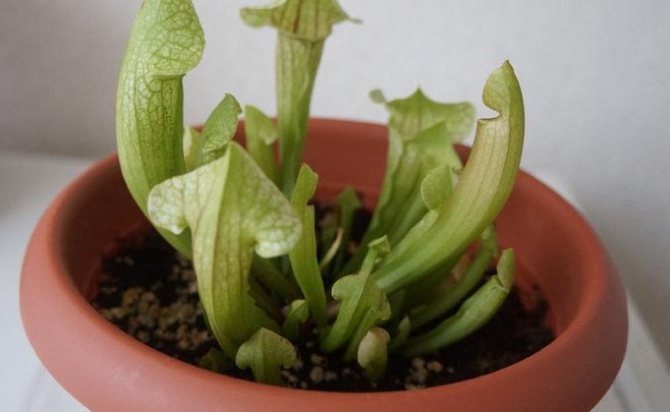

Watering sarracenia
Sarracenia is very fond of water, because it lives on the banks of reservoirs. If you planted this predator on the shore of a pond in your area, then you do not need to water it. A flower planted in a pot needs watering with water - distilled or filtered in such a way as to remove minerals and salts. Distilled water can be purchased at a gas station or auto shop, or at a pharmacy.
Check out a list of a wide variety of carnivorous plants.
Watering is done from a pallet, in which water must be constantly present in a decent amount, about half the level of the pot. It is necessary that the substrate never dries out, with the exception of hibernation. But even then it should be watered once a week, avoiding complete drying out.
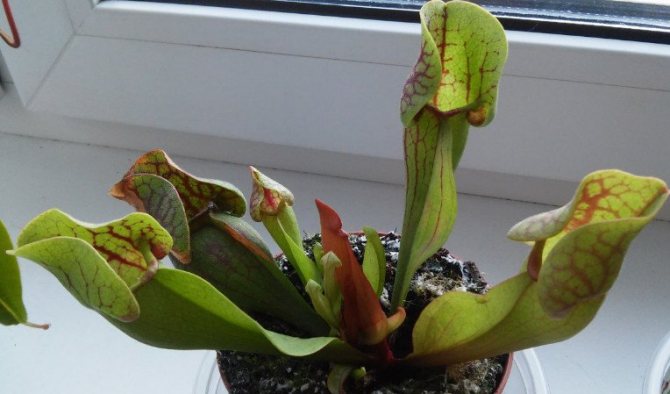

Fertilization and feeding
If your sarracenia lives in the fresh air, it does not need to be fed. She is able to take care of herself on her own and provide food that will satisfy her nutritional needs. You can offer her suitable food once, maximum twice a month.
Important! Sarracenia should never be fed with plant fertilizers - they can destroy a flower that receives everything it needs from its prey.
The predator growing in "captivity" needs additional feeding:
- small insects;
- earthworms;
- bloodworm and so on.
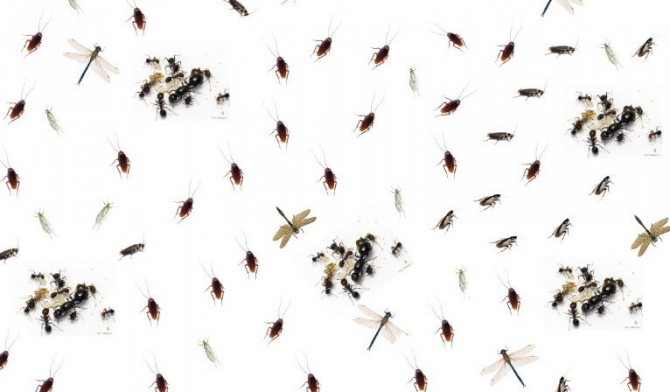

You need to feed the plant that has mature trapping leaves. If your flower did not cover the trap with an umbrella, you need to pour distilled water up to half into a tubular jug and, in order to stimulate active growth, add ants to the diet, feeding the pet several live insects once a month.
Important! Sarracenia should not be given meat, fish or dead insects.
Wintering sarracenia
All types of sarracenia require a winter respite, which lasts 3-4 months. It is necessary to overwinter sarratsia for a long existence, as well as for the realization of their own natural cycle, in particular, the possibility of flowering.
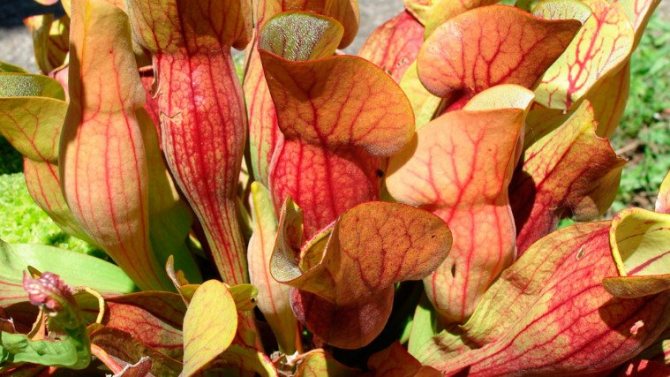

The plant should be kept in a cool room with a temperature of 0 to 10 ° C. It can overwinter comfortably, for example, in the vegetable compartment of the refrigerator. At the same time, the intensity of watering decreases sharply, and the main task for this period is not to let the substrate dry out. A weekly hydration is sufficient for this.
2. Varieties:
2.1 Sarracenia purpurea - Sarracenia purpurea
Compact herbaceous predatory perennials up to 30 cm high. The plant forms brown or bright burgundy jugs with a glossy surface. Veins on jugs can be highlighted with a darker, reddish tint. The lids of the jugs are heart-shaped, with wavy solid edges. The lids have hard, light-colored bristles directed downward into the jug. During the flowering period, the plant throws out long, thin, leafless, slightly curved peduncles in the upper part with large, burgundy flowers.
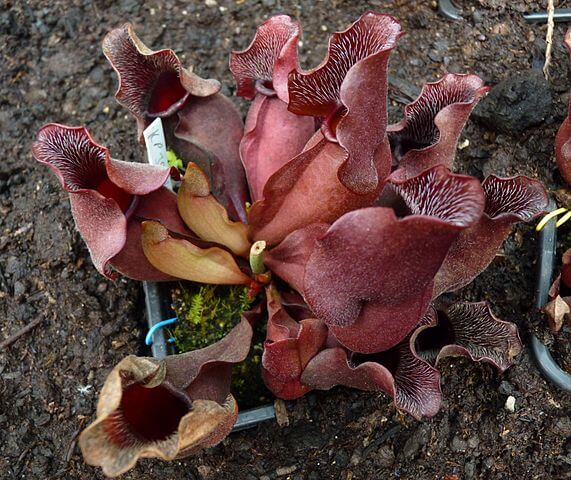

2.2. Sarracenia Drummond or Californian Darlingtonia - Darlingtonia californica
An attractive carnivorous herb with leaves that resemble the head of a cobra. In adult plants, the height of the jugs can reach 90 cm. The jugs are narrow, cylindrical, light green. In the upper part, the jugs have reddish streaks and a translucent surface that lets in sunlight. During the flowering period, the plants form vertical, thin, leafless, curved peduncles in the upper part with spectacular, large, greenish flowers.
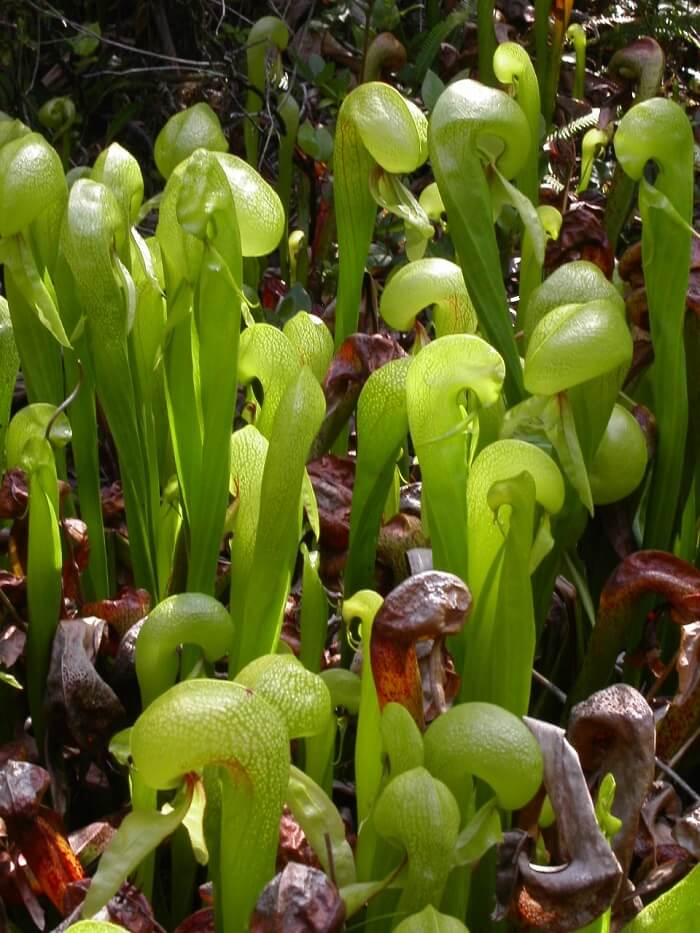

You may also be interested in:
Sarracenia is a large insectivorous perennial plant. In natural conditions, it grows in the marshlands of North America. Nutrient-depleted soils influenced the development of the mechanism for attracting and digesting insects ...
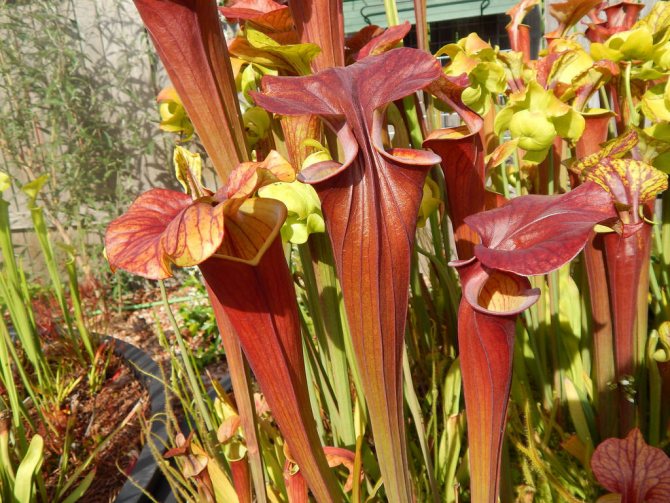

The role of the trap is played by leaves twisted into a hollow cylinder at the base and expanding towards the top. The appearance of the traps resembles conical jugs or urns. In height, such modified leaves can grow up to 1 m.
There are many varieties of Sarracenia. Their general description is the same, only the color, size and shape of flowers differ. Usually the plant has several small jug leaves, not exceeding 40 cm in height. As a rule, they have a beautiful, rich color. The entrance to the trap stands out with a bright pattern, which makes it more visible and attractive to insects. Each tubular stem has a pterygoid fringe, which forms a kind of "lid" on top.
History of the name
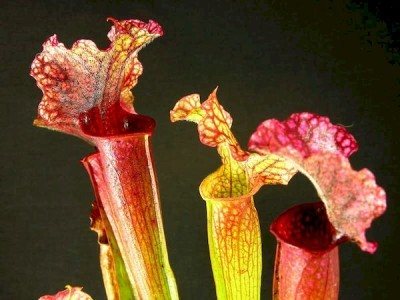

The plant is named after the tester M. Sarrazen. Belongs to the Sarraceniaceae family. Latin name: Sarracenia. In the wild, it grows in moist soils rich in peat.
Distributed in the south of America in the states of Texas, New Mexico, Arizona, Louisiana. Sarracenia can be found on the coasts of Canada and near the Great Lakes.
At home, Sarracenia Yellow is most often grown.
The flower can grow in indoor conditions, greenhouses, glazed loggias, winter and botanical gardens.This representative of the flora has emerald-amber leaves with burgundy veins. The leaves reach 0.5-1.0 meters in length.
The diameter of the water lilies depends on the length of the leaves. The larger the leaf, the larger the water lily. For half-meter leaves, the diameter of the flowers can vary between 8-10 cm. This subspecies is divided into 7 different varieties. The most popular and unpretentious variety is Red Sarracenia.
In the photo you can see all the variety of types of sarracenia:
Types and varieties of sarracenia with photos and names
A small genus has 11 species, and only a few of them are grown at home.
Sarracenia yellow Sarracenia flava
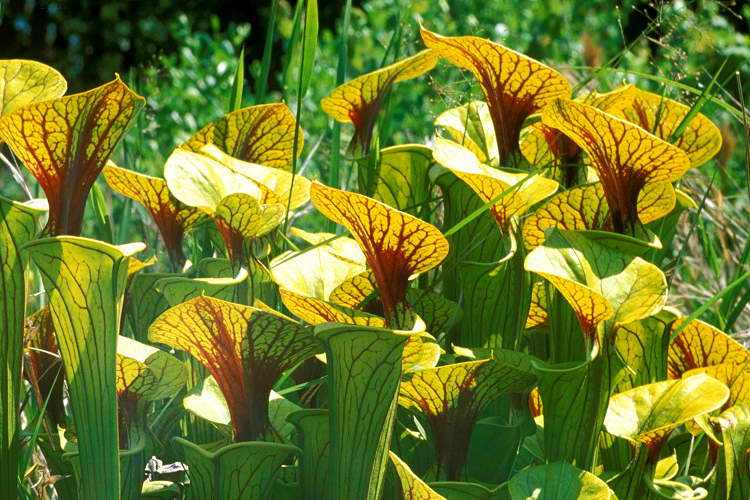

Sarracenia yellow Sarracenia flava photo
The leafy water lilies are bright green with red veins. Height is 60-70 cm. It blooms from March to April. The peduncle is drooping, yellow flowers exude a rather sharp aroma.
Sarracenia purpurea Sarracenia purpurea
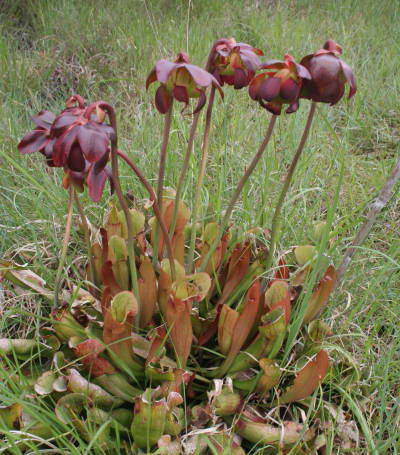

Sarracenia purpurea Sarracenia purpurea photo
The most common kind. The color of the leaves varies from dark red, burgundy to purple tones. Blooms in spring. The color of the flowers is dark red.
2 subspecies are also cultivated:
Sarracenia Purpurea Purpurea Sarracenia purpurea ssp purpurea
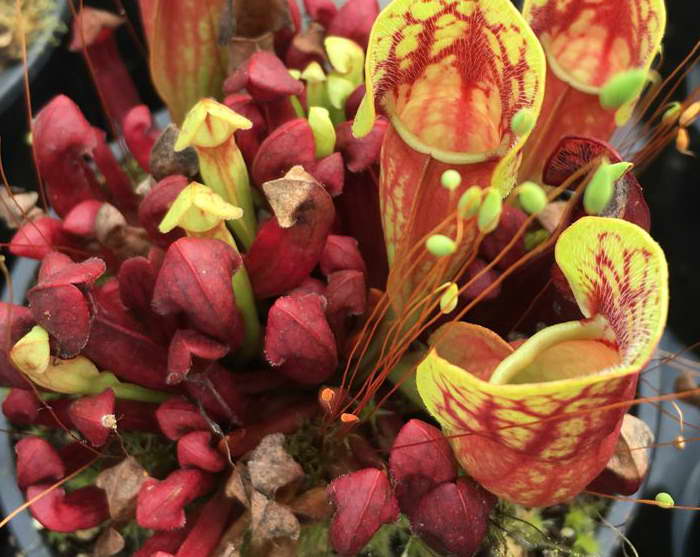

Sarracenia Purpurea Purpurea Sarracenia purpurea ssp purpurea photo
Reaches a height of 15 cm, the peduncle stretches 30 cm. Leaves are bright red, can be green or yellow-green with red veins. The flowers are colored red or greenish-red.
Sarracenia purpurea veined Sarracenia purpurea venosa
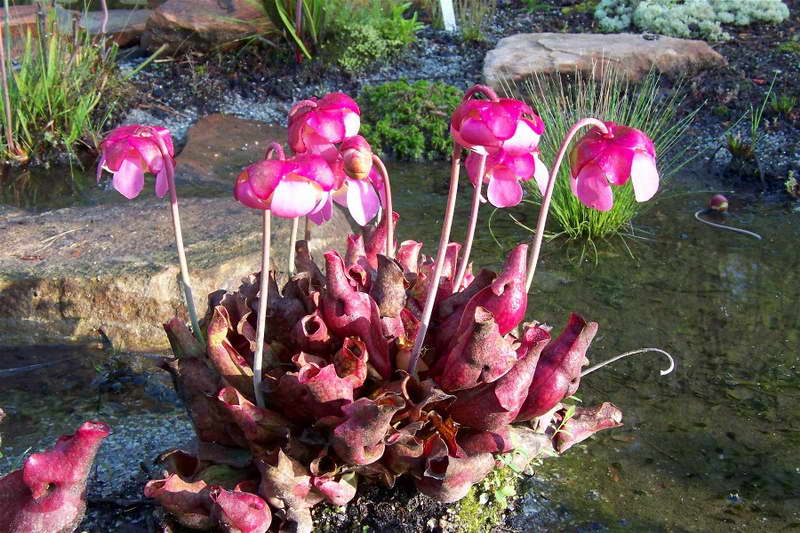

Sarracenia purple veined Sarracenia purpurea venosa photo of flowering
It has larger leaves and flowers. The color of the leaves is burgundy or green-purple. The flowers are dark burgundy, red-purple, less often pink.
Sarracenia red Sarracenia rubra
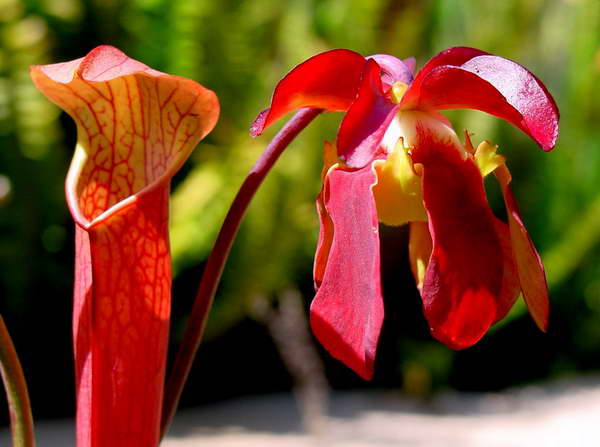

Sarracenia red Sarracenia rubra photo
The height is 20-60 cm. The red-burgundy color of the leaves turns into bright red. Flowers of bright red color appear in the spring.
The principle of catching insects
Each trap contains nectar-bearing glands that emit a delicious scent. Insects, attracted by the smell, sit on the edge of the jug and slide into the trap. On the inner walls of the trapping leaves there are villi that prevent insects from moving in the opposite direction. As a result, insects enter special storage tanks, where they dissolve under the influence of digestive juice. Thus, predatory plants provide themselves with the necessary amount of nitrogen, magnesium and calcium compounds.
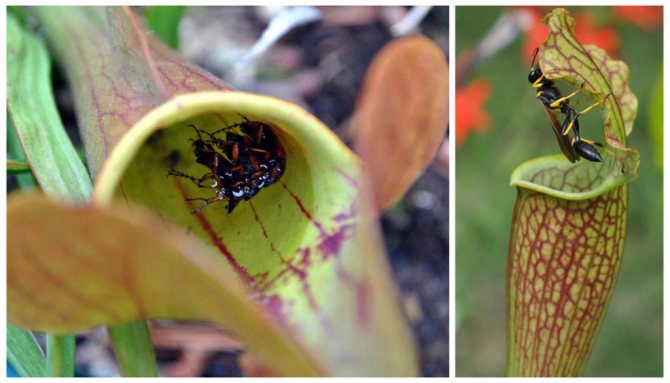

For some birds, pitchers of sarceniums play the role of feeders. Quite large species of insects often become residents of such traps. This coexistence does not bring good results for the plant. Birds, eating insects caught by the plant, damage the leaf tissue, after which the sarracenia cannot fully function and provide itself with microelements.
Problems and illnesses
A plant that has been properly cared for is virtually immune to disease. It can become a preventive trap for parasitic insects and protect all indoor flowers from the invasion of pests. But if mistakes were made in leaving, then the beautiful sissy will demonstrate all her capriciousness.
The main difficulty in pest or disease control is the ban on spraying. No substances should get inside the jug: neither folk remedies, nor insecticides. Therefore, the spraying procedure is replaced by wiping. The table contains descriptions of the main plant diseases.
Table - Sarracenia Problems and Predator Treatment Methods
| Symptoms of the problem | Cause | How to fix |
| - The plant stops growing; - a gray bloom appears on the sheet plates | - Gray rot | - Cut off all damaged areas; - Arrange daily airing of the room (but not a draft!); - treat the plant with "Fitosporin M" or "Fundazol" |
| - Sarracenia begins to wither; - small pests are visible on the plant | - Aphids | - Increase indoor humidity; - lower the temperature; - hang up the Velcro for catching insects; - remove visible pests; - cut off the damaged areas; - gently wipe the sheets with soapy water; - in case of severe damage, use insecticides: "Fitosporin", "Aktara"; - if the roots are affected by the mealybug, transplant into a new disinfected soil and remove the affected roots |
| - Deterioration in the appearance and growth of the plant is accompanied by the appearance of cotton balls on the leaf | - Mealybug | |
| - Leaf plates turn yellow and dry; - the sarracenia is entangled in a thin cobweb | - Spider mite |
So that caring for a sarracenium in a pot is not accompanied by the appearance of problems and diseases, carefully monitor the state of the green predator. Sarracenia will definitely let you know about mistakes in care. Yellow foliage indicates a light deficiency or excess potassium in the soil. And the lack of flowering and drying can signal improper wintering or insufficient watering. But if the roots or leaves begin to rot, then the watering was excessive. Transplant Sarracenia immediately and moderate soil moisture.
Wintering
For sarracenia, wintering is extremely necessary. It lasts for 3-4 months at an ambient temperature of 0-10 ° C. Due to a decrease in daylight hours and a lower temperature, the “pet” goes into hibernation. Due to the peculiarities of our region, this process takes place naturally at the end of autumn.
If the plant is wintering for the first time, then it is better to maintain the ambient temperature within the range from +5 to + 7 ° C. For "experienced" representatives of Sarracenia, the temperature can drop to -10 ° C. It is necessary to water the plant with water, the temperature of which is comparable to the temperature of the air and soil.
All daredevils who are not frightened by the predatory abilities of Sarracenia and the difficulty of its care will be rewarded with a wonderful exotic pet that pleases with its beauty!
Reproduction
Sarracenia can be propagated using seeds. Usually they are sown in peat Petri dishes, after germination of seeds, the sprouts are dived into pots. To ensure the germination of seeds, before sowing, they are cold stratified for 1 - 1.5 months.
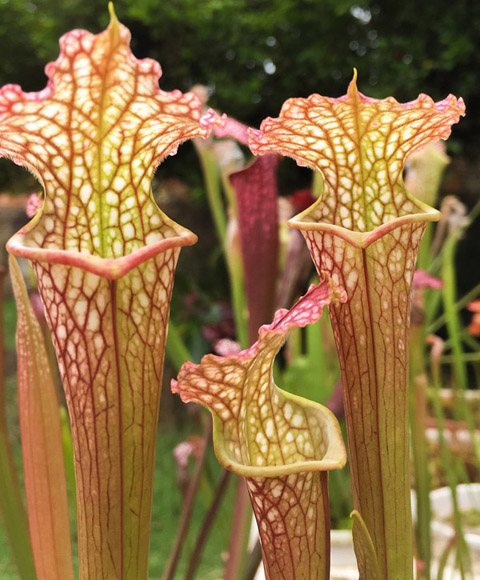

After sowing the seeds, it is necessary to water the soil regularly. Sarracenia yellow is easily bred with the help of root segments, which explains its good "homeliness". But it is possible to divide the rhizome only when the plant reaches a large size, from frequent division the flower weakens and may die.
Growing sarracenia from seeds
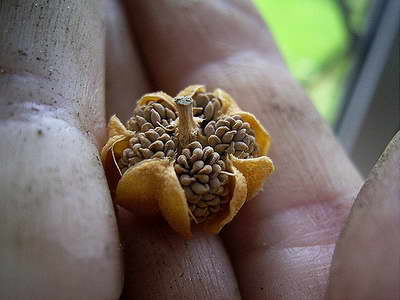

Sarracenia seeds photo
Most often propagated by seeds, since the plant does not like to be disturbed.
- Be sure to stratify the seeds before planting. Keep them in the vegetable section of the refrigerator for 4-8 weeks.
- Then soak in warm water for a day.
- Fill the container with quartz sand and sphagnum, moisten the soil, sow the seeds: spread them as rarely as possible on the surface of the soil, you do not need to sprinkle them on top.
- Moisten with a spray bottle.
- Cover crops with foil or glass. Maintain the air temperature between 23-28 ° C.
- Ventilate the greenhouse a couple of times a week. Keep soil moisture constant.
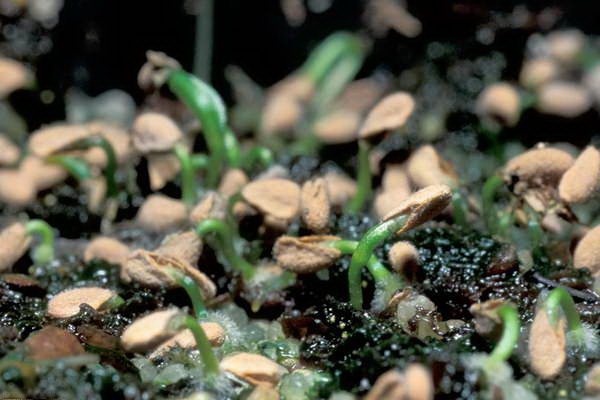

Sprouted sarracenia seeds photo
- With the emergence of seedlings, the shelter can be removed.
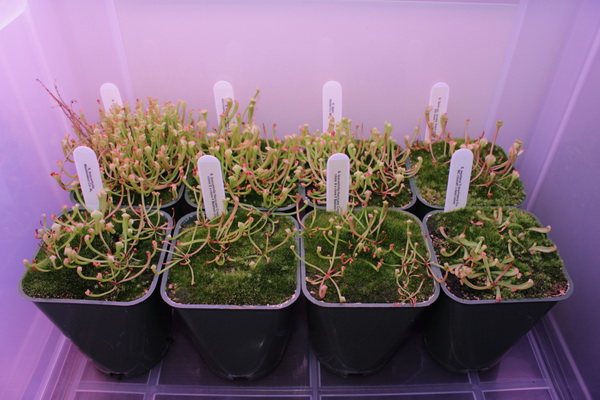

Sarracenia from seeds photo of seedlings
- It is necessary to provide 16 hours of daylight - use a phytolamp. Sarracenia grows rather slowly.
Home care
Sarracenia is a flower that can grow in a room. Home care is not much different from other plants.
Watering
This representative of the flora has a negative attitude towards chlorinated water. For irrigation, you must use boiled, filtered or settled water.
Experienced flower growers recommend watering Sarracenia with melt or rain water. If this is not possible, then you can use distilled.
But it is better to dilute it filtered, as it is low in nutrients.
Important! If you water it with hard tap water, the flower can get very sick.
Watering is done through a special pallet. Such a container must be constantly moistened. It should be filled with water or forest moss. If we take into account the fact that Sarracenia is a swamp flower, then drying out the soil will be disastrous for it.
Important! The less illumination a flower receives, the less watering it needs. With a lack of sun and frequent watering, the root system of the flower can rot.
Transfer
The transplant is carried out before the start of active growth and vegetation. Usually, the procedure is performed once every two years.
Experienced growers recommend removing all dried leaves and cleaning the root system of old soil. The flower is transplanted in a container with a larger diameter.
It should be noted that the flower actively grows and develops in deep containers.
Soil, soil (choice of pot)
The soil should be loose and breathable. It is prohibited to add additional fertilizing in the form of humus or peat. The earth doesn't have to be nutritious.
Sarracenia grows well in acidic soil above pH 5. Forest moss, perlite, coarse-grained sea sand, charcoal are added to the soil. After purchase, the flower must be transplanted immediately.
Vendors do not follow the plant's preferences, using whatever water and soil is available. Chlorine that remains in the soil after watering can negatively affect the health of the flower. The containers are chosen from wood or clay.
Fertilizer
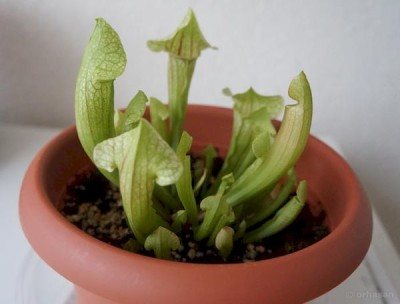

This representative of the flora does not need feeding. Unlike other plants, Sarracenia actively grows in poor and scarce substrates.
The flower receives all the necessary minerals and vitamins from digestible insects that fall into the trap.
The flower is able to feed itself. But sometimes growers themselves dip flies and ants into fully formed water lilies with digestive fluid.
This procedure must be performed at least once a month. If in the summertime the plant is taken out to an open balcony or into a garden, then the insects will fall into the trap themselves.
Temperature
Sarracenia perfectly tolerates temperature extremes. It can grow actively at both low and high temperatures. In case of intense heat above 36 ° C, the plant will need additional air humidification and abundant watering.
Air humidity should be around 35-45%. In winter, when the flower is at rest, the plant is transferred to a cooler room. At this time, the temperature should be in the range of 10-12 ° C.
Lighting
The plant loves bright natural light. For the health and active growth of Sarracenia, more than 9 hours of direct sunlight are needed.
If it is not possible to provide this representative of the flora with such a regime, then the plant is artificially illuminated.
Phytolamps are perfect. Thanks to them, the illumination level will be equal to 4900-5100 lux. You should know that the flower does not tolerate changes in its location relative to the sun.
Therefore, turning it 90 ° -180 ° is strictly prohibited. Sarracenia is planted in a permanent place immediately.
How to take care of sarraceny at home
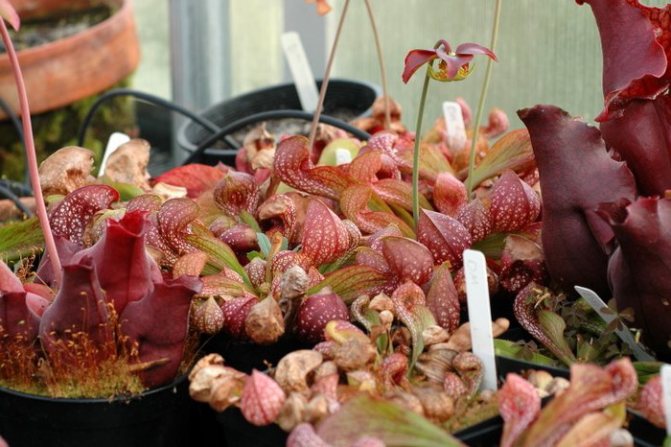

How to take care of sarraceny at home
Lighting
Sarracenia is photophilous, but does not like direct sunlight. She needs 8-10 hours of daylight. It is best to place the pot with the plant on the eastern or western window sills; on the southern window, you will need protection from direct sunlight.
Watering and humidity
In the natural environment, it lives in marshy areas, near lakes and rivers, therefore it is important to ensure constant soil moisture. Water frequently during warmer months to keep the soil from drying out. Water about once a week between October and April.
Prefers moderate humidity (about 40%). Do not spray the plant, but periodically place it on a drip tray.
Top dressing
For such a peculiar plant, special feeding will be required. Sarracenia can be fed only with small insects (bloodworms, earthworms are suitable). Feed plants with mature trapping leaves. Do this once a month during the summer.
If the trap is not covered with an umbrella, the tubular jug should be filled up to half with distilled water. In this case, during the period of active growth, to maintain the acidity level, ants should be fed monthly.
Dormant period
The plant needs to provide proper conditions during the dormant period. From late autumn to spring, keep the air temperature at + 5-7. Sprinkle with water at the same temperature.
Choosing dishes or container for planting
A container for sarracenia should be chosen such that moisture and drainage of the substrate can be ensured. These can be plastic or glass pots with large drainage holes so that excess water can drain freely. Pots made of ceramics or other porous materials are not suitable - they tend to absorb moisture.
[collapse]
Why is a predator flower bred?
Some varieties of Sarracenia look very bright and decorative. Due to their unusual and exotic appearance, they are cultivated in many countries. Particular preference is given to the yellow variety. Sarracenia attracts the eye with pale orange flowers and a graceful shape of curved greenish jug-like leaves. Growers love the purple variety due to the surprisingly delicate scent of violets.
If you provide a perennial with abundant watering and sufficiently good conditions of detention, it is not necessary to feed it with insects.
Transfer
A transplant is carried out every 2-3 years in early spring in order to renew the soil mixture, which is prepared from peat, coarse-grained washed sand and dry sphagnum moss (can be replaced with perlite) in a ratio of 2: 1: 1 or peat and perlite (1: 1) ...
You can find out how to grow moss in the house here
It is also helpful to add chunks of charcoal. The mixture must be loose and permeable. The withered ground part is removed, the plant is carefully removed, the roots are shaken off from the old substrate and planted in a new pot, after having laid out a drainage layer of expanded clay or fine gravel on the bottom.
A layer of live moss is spread over the top of the soil to maintain moisture.

